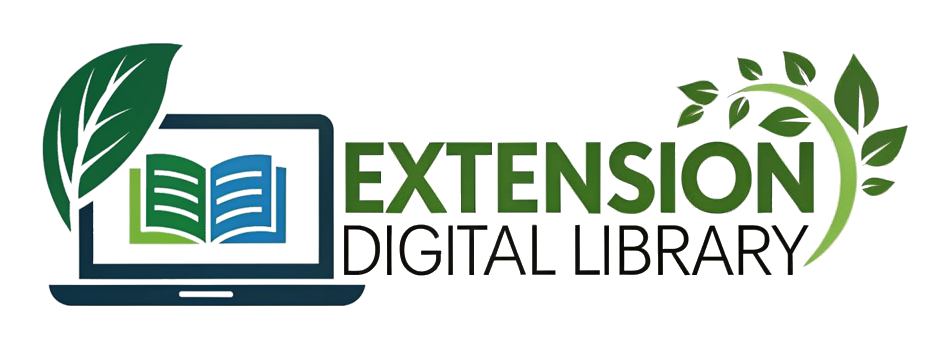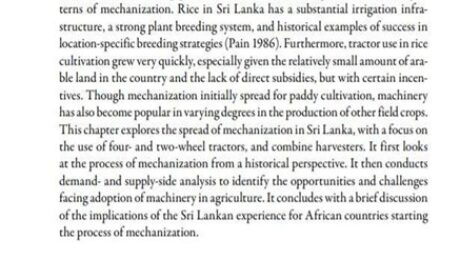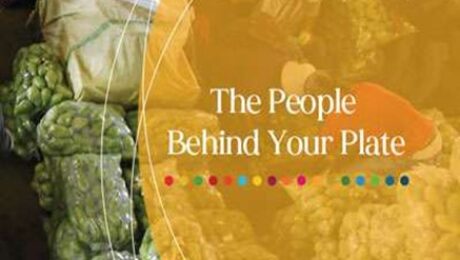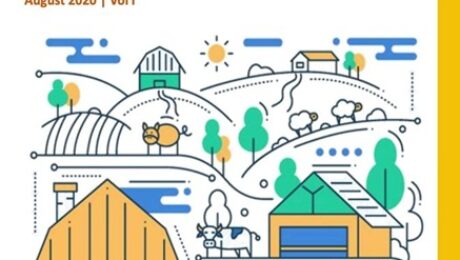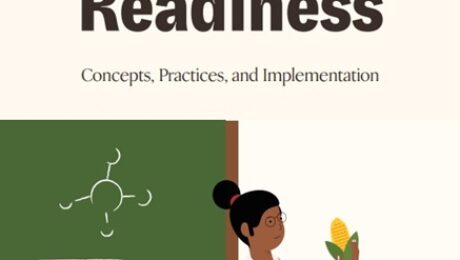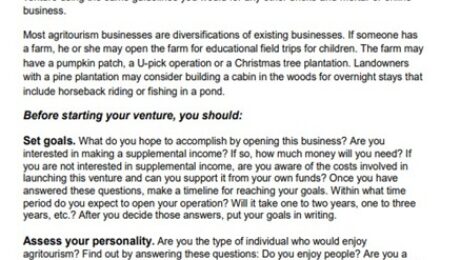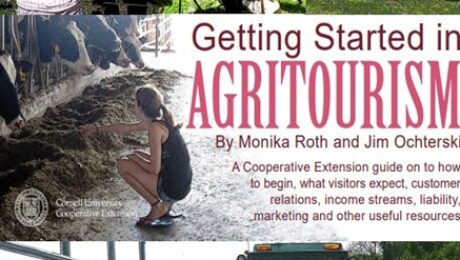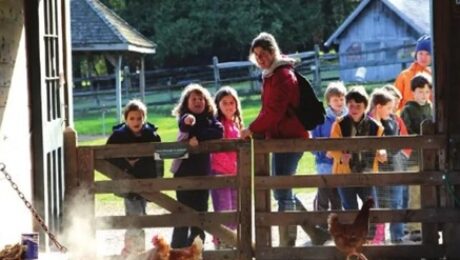The evolution of agricultural mechanization in Sri Lanka
Sri Lanka’s unique geography and its distinct experiences with machine use in rice and field crop production offer valuable insights into different patterns of mechanization. Rice in Sri Lanka has a substantial irrigation infrastructure, a strong plant breeding system, and historical examples of success in location-specific breeding strategies (Pain 1986). Furthermore, tractor use in rice cultivation grew very quickly, especially given the relatively small amount of arable land in the country and the lack of direct subsidies, but with certain incentives. Though mechanization initially spread for paddy cultivation, machinery has also become popular in varying degrees in the production of other field crops. This chapter explores the spread of mechanization in Sri Lanka, with a focus on the use of four- and two-wheel tractors, and combine harvesters. It first looks at the process of mechanization from a historical perspective. It then conducts demand- and supply-side analysis to identify the opportunities and challenges facing adoption of machinery in agriculture. It concludes with a brief discussion of the implications of the Sri Lankan experience for African countries starting the process of mechanization.
- Published in CONCEPTS AND PRACTICES
AFAAS- Stories from 10 Country Forums – Year 2020
The Country Fora (CFs) are building blocks of AFAAS and bring together a wide range of actors and stakeholders involved in or benefitting from agricultural extension and advisory services (AEAS) in a country. They provide mechanisms for the diverse actors – including farmers – to exchange information, share lessons, identify opportunities for providing services to each other, and for innovating for effective services. It was anticipated that the CFs will evolve into providing leadership to the overall development of effective AEAS in particular countries and serve as springboard for innovations and entry points for regional and international initiatives in improving AEAS and rural livelihood in general.
- Published in CONCEPTS AND PRACTICES
The People Behind Your Plate
The book is organized around the “5 Ps” of people, planet, prosperity, peace and partnerships. The work that rural people do, including growing food and taking care of precious natural resources, is at the heart of the 2030 Agenda.
The Sustainable Development Goals outline 17 areas for eliminating poverty and hunger, protecting the planet, and promoting peace and prosperity. These priorities are fundamental to the transformation of rural areas. The stories in this book show how IFAD invests in rural people to support their efforts, knowledge and skills as they help solve some of the world’s most urgent challenges.
- Published in CONCEPTS AND PRACTICES
Co-creating Sustainable Livelihoods in India
The livelihoods sector has undergone a significant transformation over the past decade and is expected to see even greater shifts over the coming years, given the unprecedented times that stand ahead of us. Livelihoods are a critical pathway to eliminating poverty and driving sustainable economic growth for communities. It is thus crucial to bring forth opportunities that have potential to transform systems that create sustainable livelihoods across the value chain, despite the dynamically evolving challenges. It is important to anticipate that collaboration and co-creation are the most critical enablers of sustainable livelihood in rural and urban India. Not only does it preserve the resources involved in re-invention, it also allows us to leveraging cross sectoral expertise & enables collective action to achieve impact at a large scale.
Keeping this very idea at its heart, the India Livelihoods Collective has undertaken numerous initiatives since its inception, providing a collaborative platform for diverse organisations to come together in catalysing the process of achieving livelihoods goals in India. Extending its efforts in this direction, this document provides specially curated 45 livelihoods practices initiated by Corporates, NGOs, Impact Investors, Start-ups, Academia and other enablers in the livelihoods ecosystem. The compendium maps the avenues for collaboration to scale-up and replicate these practices, highlighting the challenges, key learnings, livelihoods outcomes and impact on livelihoods sustainability.
- Published in CONCEPTS AND PRACTICES
Syngenta Foundation for Sustainable Agriculture Farmers’ Hub Impact Insights Bangladesh
The Syngenta Foundation for Sustainable Agriculture was established in 2001 to improve the livelihoods of smallholder farmers in poorer regions of the world. Since its beginnings, the Foundation has been instrumental in delivering sustainable agriculture initiatives for pre-commercial smallholders.
In recent years Syngenta Group has been strengthening its own strategic efforts to support commercial smallholders with innovative and transformative solutions. This includes improved access to products, agronomic training, and markets, and a large network of agricultural centers across China, Africa, Asia, and Central America.
- Published in CONCEPTS AND PRACTICES
Using Open Science to Maximize SDG Impact – A Case Study on Chagas Disease
It is no wonder that Chagas disease was included in the list of neglected tropical diseases by the World Health Organization in 2007 (WHO, 2020). Over 100 years have passed since Chagas was first discovered and there is still no appropriate solution to this problem, which mainly affects marginalized communities around the globe.
Chagas constitutes a socio-environmental problem (Sanmartino, 2015) that interacts with several Sustainable Development Goals (SDGs) in addition to good health and wellbeing (SDG 3). For instance, education and access to information is key for prevention; better infrastructure, including roads and hospitals, is important for early detection and treatment; while changes in ecological systems, due to production activities and climate change, have moved the vector (i.e. the kissing bugs that may transmit the disease) towards new, frequently urban, areas.
- Published in CONCEPTS AND PRACTICES
Scaling Readiness- Concepts, Practices, and Implementation
Scaling Readiness supports organizations, projects, and programs in achieving their ambitions to scale innovations. Scaling Readiness encourages critical reflection on how ready innovations are for scaling and what appropriate actions could accelerate or enhance scaling. Scaling Readiness treats innovation as a flexible package of technological, organizational, and institutional components that may include crop varieties, machines or equipment, crop production practices, legislation, and marketing campaigns.
An innovation may be ready in a technical sense – for example, a new crop variety may thrive in the local environment – but, if farmers lack funds to buy seed or if the policy environment discourages the uptake of new varieties, it may not be adopted at scale. Scaling Readiness assesses the potential of innovations to be used at scale and guides research and development intervention managers in implementing these innovations in practical contexts. Through its standardized data collection and analysis approach, Scaling Readiness can also be used to monitor an intervention portfolio at organizational level, allowing for evidence based management.
- Published in CONCEPTS AND PRACTICES
12 Things to Consider When Starting an Agritourism Business
Agritourism is a business venture on a working farm, ranch or agricultural enterprise that blends entertainment, education and tourism to provide a fun, exciting and memorable experience for people of all ages. Because it is a business, structure the venture using the same guidelines you would for any other bricks-and-mortar or online business.
Most agritourism businesses are diversifications of existing businesses. If someone has a farm, he or she may open the farm for educational field trips for children. The farm may have a pumpkin patch, a U-pick operation or a Christmas tree plantation. Landowners with a pine plantation may consider building a cabin in the woods for overnight stays that include horseback riding or fishing in a pond.
- Published in AGROTOURISM
Getting Started in Agritourism
There is a great deal of interest in agritourism as a niche tourism sector for farms. People are looking for an authentic farm experience that might link them to their past or that teaches them something new. Visitors also want relief from the stress of everyday life to experience a seemingly simpler life. Farm visits offer a day in the country, where guests may pick berries, go for a hayride, sample
homegrown or homemade products, see animals, and learn how farms operate.
READ MORE
- Published in AGROTOURISM
A Guide to Successful Agritourism Enterprises
Agritourism activities are becoming an important component of many farm operations. These activities have the potential to increase farm revenues and maintain the sustainability of the industry. However, agritourism activities won’t suit every farm or farmer. Before starting an agritourism operation, it is recommended that farmers spend some time assessing the potential that these activities have for their operation, and carefully planning the business and marketing elements of their operation. This guide will help with all the planning that goes into running successful agritourism operations.
- Published in AGROTOURISM
